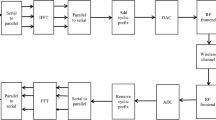Abstract
The FBMC generation techniques are found to surmount the disadvantages of the IFFT/FFT based OFDM system. The minimization of PAPR is a much sought after solution by all multi-carrier methods. This paper investigates the possibility of a unified approach for error control coding and PAPR minimization in an FBMC-OQAM system. A new coding procedure called Constrained Message Length (CML) coding is presented in this paper. A new perspective on PAPR and an analytical framework for estimating the PAPR is also presented. Hybrid techniques using coding and companding are tested for different channel models, and their BER performance is on par with the BCH system. The proposed system is of low complexity and has a PAPR of only 3.81 dB, which is better than or comparable with the existing systems that are using complex methods. This paper has uniquely investigated the dependence of PAPR on the input data variation for a different set of random data loads. The CML coding proposed here can minimize the input data dependent PAPR deviation to a low variance of 0.045 dB, which provides an increased linear region of operation to the power amplifier in the RF section.









Similar content being viewed by others
References
Peled, A., & Ruiz, A. (1980). Frequency domain data transmission using reduced computational complexity algorithms. ICASSP'80. In IEEE international conference on acoustics, speech, and signal processing (pp. 964–967). Denver, Colorado, USA. https://doi.org/https://doi.org/10.1109/ICASSP.1980.1171076.
Vitterli, M. (1987). Theory of multirate filter banks. IEEE Transactions on Accoustics, Speech and Signal Processing, 35(3), 356–372. https://doi.org/10.1109/TASSP.1987.1165137.
Jawhar, Y. A., Ramli, K. N., Taher, M. A., Shah, N. S. M., Audah, L., Ahmed, M. S., et al. (2018). New low-complexity segmentation scheme for the partial transmit sequence technique for reducing the high PAPR value in OFDM systems. ETRI Journal., 40(6), 699–713. https://doi.org/10.4218/etrij.2018-0070.
Eldessoki, S., Dommel, J., Hassan, K., Thiele, L., & Fischer, R. F. H. (2016). Peak-to-average-power reduction for FBMC-based systems. WSA 2016. In 20th International ITG workshop on smart antennas, Munich, Germany (pp. 1–6). https://ieeexplore.ieee.org/stamp/stamp.jsp?tp=&arnumber=7499164&isnumber=7499094.
Qu, D., Lu, S., & Jiang, T. (2013). Multi-block joint optimization for the peak-to-average power ratio reduction of FBMC-OQAM signals. IEEE Transactions on Signal Processing, 61(7), 1605–1613. https://doi.org/10.1109/TSP.2013.2239991.
Lu, S., Qu, D., & He, Y. (2012). Sliding window tone reservation technique for the peak-to-average power ratio reduction of FBMC-OQAM signals. IEEE Wireless Communications Letters, 1(4), 268–271. https://doi.org/10.1109/WCL.2012.062512.120360.
Kollar, Z., & Horvath, P. (2012). PAPR reduction of FBMC by clipping and its iterative compensation. Journal of Computer Networks and Communications. https://doi.org/10.1155/2012/382736.
Varghese, N., Chunkath, J., & Sheeba, V. S. (2014). Peak-to-average power ratio reduction in FBMC-OQAM system. In 2014 Fourth IEEE international conference on advances in computing and communications, Cochin (pp. 286–290). https://doi.org/https://doi.org/10.1109/ICACC.2014.74
Shaheen, I. A., Zekry, A., Newagy, F., & Ibrahim, R. (2019). Performance evaluation of PAPR reduction in FBMC system using non-linear companding transform. ICT Express, 5(1), 41–46. https://doi.org/10.1016/j.icte.2018.01.017.
Agarwal, A., & Sharma, R. (2020) Review of different PAPR reduction techniques in FBMC-OQAM system. In Balas, V., Solanki, V., & Kumar, R. (Eds.), Internet of Things and Big Data Applications. Intelligent Systems Reference Library (Vol. 180). Cham: Springer. http://doi.org/https://doi.org/10.1007/978-3-030-39119-5_14.
Na, D., & Choi, K. (2018). Low PAPR FBMC. IEEE Transactions on Wireless Communications, 17(1), 182–193. https://doi.org/10.1109/TWC.2017.2764028.
Zhao, J., Ni, S., & Gong, Y. (2017). Peak-to-Average Power Ratio Reduction of FBMC/OQAM Signal Using a Joint Optimization Scheme. IEEE Access, 5, 15810–15819. https://doi.org/10.1109/ACCESS.2017.2700078.
Wang, H., Wang, X., Xu, L., & Du, W. (2016). Hybrid PAPR reduction scheme for FBMC/OQAM systems based on multi data block PTS and TR methods. IEEE Access, 4, 4761–4768. https://doi.org/10.1109/ACCESS.2016.2605008.
Ramesh, B., Senthilkumar, J., Suresh, Y., et al. (2019). Filter bank multicarrier based generalized discrete fourier transform for peak to average power ratio reduction. Mobile Network Application, 24, 1793–1803. https://doi.org/10.1007/s11036-019-01391-8.
ITU Recommendation ITU-R M.1225. (1997). International Telecommunication Union, Geneva.
Hara, S., & Prasad, R. (2003). Multi-carrier techniques for 4G Mobile communications. New York: Artech House, Inc.
Hari, K. V. S. (2011). Channel models for wireless communication systems. In Kennington, J., Olinick, E., & Rajan, D. (Eds.), Wireless network design. International Series in Operations Research & Management Science, vol 158. New York, NY: Springer. http://doi.org/https://doi.org/10.1007/978-1-4419-6111-2_3.
Maxson, D. P. (2007). The IBOC handbook. New York: Routledge. https://doi.org/10.4324/9780080927428.
Bhargava, V. K., Yang, Q., & Peterson, D. J. (1993). Coding theory and its applications in communication systems. Defense Science Journal, 43(1), 59–69.
Vaidyanathan, P. P. (2006). Fundamentals of multirate systems. In Multirate systems and filter banks (pp. 100–163). Pearson Education India.
Acknowledgement
The authors would like to thank Prof. Ramjee Prasad, Editor-in-Chief of the Wireless Personal Communication, and anonymous reviewers for their valuable comments, which helped to improve the presentation of the paper.
Author information
Authors and Affiliations
Corresponding author
Additional information
Publisher's Note
Springer Nature remains neutral with regard to jurisdictional claims in published maps and institutional affiliations.
Rights and permissions
About this article
Cite this article
Chunkath, J., Sheeba, V.S. Constrained Message Length Coding for Low Peak to Average Power Ratio in FBMC: OQAM Systems. Wireless Pers Commun 116, 2981–2996 (2021). https://doi.org/10.1007/s11277-020-07830-0
Published:
Issue Date:
DOI: https://doi.org/10.1007/s11277-020-07830-0




